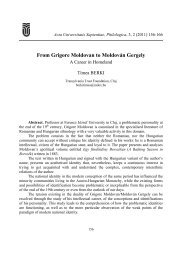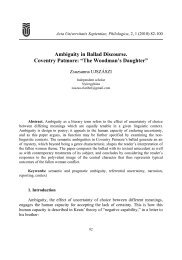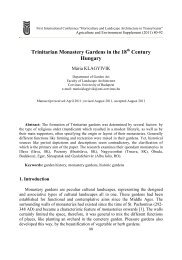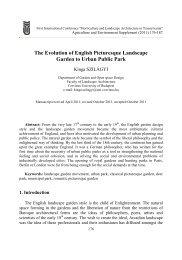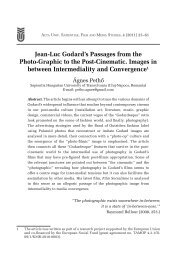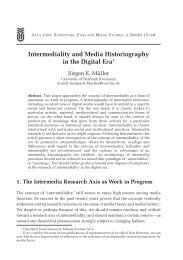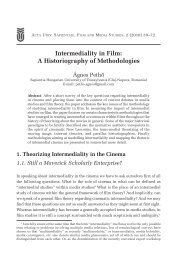Frame, Space, Narrative. Doors, Windows and Mobile Framing in ...
Frame, Space, Narrative. Doors, Windows and Mobile Framing in ...
Frame, Space, Narrative. Doors, Windows and Mobile Framing in ...
Create successful ePaper yourself
Turn your PDF publications into a flip-book with our unique Google optimized e-Paper software.
ACTA UNIV. SAPIENTIAE, FILM AND MEDIA STUDIES, 2 (2010) 91–106<br />
<strong>Frame</strong>, <strong>Space</strong>, <strong>Narrative</strong>. <strong>Doors</strong>, <strong>W<strong>in</strong>dows</strong><br />
<strong>and</strong> <strong>Mobile</strong> <strong>Fram<strong>in</strong>g</strong> <strong>in</strong><br />
the Films of Luch<strong>in</strong>o Visconti<br />
Ivo Blom<br />
VU University Amsterdam (The Netherl<strong>and</strong>s)<br />
E-mail: il.blom@let.vu.nl<br />
Abstract: In the last years, film <strong>and</strong> media studies are more <strong>and</strong> more<br />
discover<strong>in</strong>g or rather appropriat<strong>in</strong>g ideas from art history <strong>and</strong> art theory, <strong>in</strong><br />
particular iconology. This has led to great attention for the work of Aby<br />
Warburg <strong>and</strong> Ernst Panofsky. In particular the concept of motif has lead to<br />
publications such as Michael Walker’s Hitchcock’s Motifs (2005), <strong>and</strong>, most<br />
recently, the article ”Medienwissenschaft der Motive” (2009) by André<br />
Wendler <strong>and</strong> Lorenz Engell. 1 In the underly<strong>in</strong>g article, the motif of the door<br />
<strong>in</strong> the films of Luch<strong>in</strong>o Visconti will be researched, <strong>in</strong> comparison with, <strong>in</strong><br />
particular 17 th century, pa<strong>in</strong>t<strong>in</strong>g. The fram<strong>in</strong>g by doors <strong>in</strong> art <strong>and</strong> film will<br />
be compared with the motif of the fram<strong>in</strong>g w<strong>in</strong>dow, while differences with<br />
mobile fram<strong>in</strong>g will be traced. F<strong>in</strong>ally, the results will be embedded with<strong>in</strong><br />
contemporary ideas on <strong>in</strong>termediality.<br />
In his <strong>in</strong>trigu<strong>in</strong>g study L’<strong>in</strong>stauration du tableau (1993), released <strong>in</strong> English as<br />
The Self-Aware Image: An Insight <strong>in</strong>to Early Modern Meta-Pa<strong>in</strong>t<strong>in</strong>g (1997), the<br />
Romanian art historian Victor Stoichita researched the phenomenon of fram<strong>in</strong>g<br />
<strong>in</strong> art, <strong>in</strong> particular the effect of the frame with<strong>in</strong> the frame of a pa<strong>in</strong>t<strong>in</strong>g. He<br />
connects this with the creation of depth, <strong>and</strong> with<strong>in</strong> this matter, he analyzes the<br />
functions <strong>and</strong> the representations of mirrors, pa<strong>in</strong>t<strong>in</strong>gs <strong>and</strong> maps with<strong>in</strong> the<br />
representation, but he also deals with the representation of doors <strong>and</strong> w<strong>in</strong>dows<br />
<strong>in</strong> early modern pa<strong>in</strong>t<strong>in</strong>g. For research <strong>in</strong>to depth <strong>and</strong> fram<strong>in</strong>g <strong>in</strong> c<strong>in</strong>ema, <strong>in</strong><br />
particular the work of the Italian filmmaker Luch<strong>in</strong>o Visconti, Stoichita’s work<br />
proved to be an extremely useful source <strong>in</strong> order to compare early modern but<br />
also 19 th century pa<strong>in</strong>t<strong>in</strong>g, silent c<strong>in</strong>ema, <strong>and</strong> the c<strong>in</strong>ema of the 1930s <strong>and</strong> 1940s<br />
with the c<strong>in</strong>ema of Luch<strong>in</strong>o Visconti.<br />
1 The article is part of a special issue on motifs of the new journal zfm. Zeitschrift für<br />
Medienwissenschaft.
92<br />
Ivo Blom<br />
The Door as <strong>Frame</strong> with<strong>in</strong> a <strong>Frame</strong><br />
With<strong>in</strong> Visconti’s films, the door open<strong>in</strong>g often functions as a frame with<strong>in</strong> a frame.<br />
In The Self-Aware Image, Victor Stoichita makes an <strong>in</strong>terest<strong>in</strong>g division between<br />
door <strong>and</strong> w<strong>in</strong>dow open<strong>in</strong>gs (Stoichita 1997, 47–68). In early modern pa<strong>in</strong>t<strong>in</strong>g, the<br />
w<strong>in</strong>dow opens the <strong>in</strong>terior to the exterior, permitt<strong>in</strong>g light to come <strong>in</strong> <strong>and</strong> offer<strong>in</strong>g<br />
a view towards the outside. That is how we see w<strong>in</strong>dows often represented. Much<br />
less often, we encounter examples of watch<strong>in</strong>g through a w<strong>in</strong>dow towards the<br />
<strong>in</strong>side while st<strong>and</strong><strong>in</strong>g outside. <strong>Doors</strong> mostly do not have that visual function. You<br />
can pass a door either towards the <strong>in</strong>side or the outside. Still, doors can also<br />
function as a k<strong>in</strong>d of w<strong>in</strong>dow, <strong>in</strong> the Albertian sense, when they offer us a view of<br />
the space beh<strong>in</strong>d the door. Not only can they offer a view from <strong>in</strong>side to outside or<br />
from outside to <strong>in</strong>side, but, while we rema<strong>in</strong> <strong>in</strong>side, they can also show us another<br />
space, beyond the door. The open door thus connects two adjacent spaces. While<br />
we are <strong>in</strong>side <strong>in</strong> the world of culture, the w<strong>in</strong>dow offers a view towards nature<br />
outside; with the door, however, we can stay with<strong>in</strong> the world of culture, of<br />
domestic space. That’s why Stoichita states that the door open<strong>in</strong>g is the matrix of<br />
<strong>in</strong>terior <strong>and</strong> genre pa<strong>in</strong>t<strong>in</strong>g. Of course these are a bit sweep<strong>in</strong>g statements, <strong>and</strong> we<br />
will see this even more when project<strong>in</strong>g his analysis onto film: <strong>in</strong> c<strong>in</strong>ema, open<br />
doors can also give views on streets <strong>and</strong> gardens, while sometimes w<strong>in</strong>dows are<br />
used to climb from the outside <strong>in</strong> (say burglars) or from the <strong>in</strong>side out (take<br />
rebellious teenagers). And as we will notice, views from outside to <strong>in</strong>side are very<br />
common <strong>in</strong> film, especially when the camera st<strong>and</strong>s outside <strong>and</strong> shoots persons<br />
<strong>in</strong>side st<strong>and</strong><strong>in</strong>g <strong>in</strong> front of an open w<strong>in</strong>dow or beh<strong>in</strong>d a glass w<strong>in</strong>dow.<br />
The motif of doubl<strong>in</strong>g of the frame by use of the door open<strong>in</strong>g is already visible<br />
<strong>in</strong> medieval art <strong>and</strong> thrived <strong>in</strong> Flemish pa<strong>in</strong>t<strong>in</strong>g of the 15 th century, but whereas<br />
the motif had not been developed yet as a meta-pictorial issue, it surely became<br />
one <strong>in</strong> 17 th century pa<strong>in</strong>t<strong>in</strong>g. The door became a topos. In the second half of the<br />
17 th century, the door appears as a prom<strong>in</strong>ent motif <strong>in</strong> Dutch pa<strong>in</strong>t<strong>in</strong>g, <strong>in</strong> its<br />
separation <strong>and</strong> connection of two adjacent <strong>in</strong>terior spaces. One of the oldest<br />
examples is The Sleep<strong>in</strong>g Maid/The Idle Servant (National Gallery, London, 1655)<br />
by Nicolaes Maes. The difference from previous pa<strong>in</strong>t<strong>in</strong>gs such as Pieter Aertsen’s<br />
Christ with Maria <strong>and</strong> Martha (Kunsthistorisches Museum, Vienna, 1552) is that<br />
here the space beh<strong>in</strong>d is not a religious scene, but a second genre scene, a second<br />
<strong>in</strong>terior scene. The viewer looks via the foreground <strong>and</strong> the frame of the image to<br />
a second space <strong>in</strong> the background, by means of the door open<strong>in</strong>g. So there are two<br />
parallel frames, that are <strong>in</strong> close contact with each other, <strong>in</strong> contrast with previous
<strong>Frame</strong>, <strong>Space</strong>, <strong>Narrative</strong>. <strong>Doors</strong>, <strong>W<strong>in</strong>dows</strong> <strong>and</strong> <strong>Mobile</strong> <strong>Fram<strong>in</strong>g</strong>...<br />
examples like Diego Velazquez’ Christ <strong>in</strong> the House of Mary <strong>and</strong> Martha (London,<br />
National Gallery, 1618). In the second half of the 17 th century, this gaze through<br />
the open door, the famous Dutch “doorkijkje” or see-through, becomes a constant<br />
motif <strong>in</strong> the work of Maes, Pieter de Hooch <strong>and</strong> others. Samuel van Hoogstraten<br />
even went further. In his pa<strong>in</strong>t<strong>in</strong>gs View of a Corridor or The Slippers (Louvre,<br />
Paris, 1658) <strong>and</strong> View of a Corridor (Dyrham Park, Gloucestershire, 1662) [Fig. 1.]<br />
we have two representations <strong>in</strong> which humans are even almost absent. At most,<br />
we notice references to their presence, such as the woman on the Gerard Terborchlike<br />
pa<strong>in</strong>t<strong>in</strong>g <strong>in</strong> the back, the broom <strong>and</strong> the slippers <strong>in</strong> the first mentioned<br />
pa<strong>in</strong>t<strong>in</strong>g; <strong>and</strong> the dog <strong>and</strong> the swab <strong>in</strong> the foreground <strong>and</strong> the cat <strong>in</strong> the middle<br />
plane of the second pa<strong>in</strong>t<strong>in</strong>g, <strong>and</strong> only the vague contour of a man <strong>in</strong> the back<br />
room, seen from beh<strong>in</strong>d. We are look<strong>in</strong>g at an almost pure <strong>in</strong>terior, as a seem<strong>in</strong>gly<br />
endless cha<strong>in</strong> of door posts, the sign of a parallel research by Hoogstraten which<br />
eventually led to his well-known perspective peepshows, <strong>in</strong> which he offered<br />
three-dimensional looks onto a Dutch <strong>in</strong>terior through peepholes at the far ends<br />
of the box. Here too we notice a fasc<strong>in</strong>ation for the pure <strong>in</strong>terior; man seems<br />
present only casually, <strong>in</strong> the foreground. Hoogstraten’s Slippers conta<strong>in</strong>s even an<br />
extra door post, of which we notice a part on the right side. So the frame of the<br />
picture looks like a door open<strong>in</strong>g itself.<br />
F<strong>in</strong>ally Stoichita discusses Johannes Vermeer’s well-known Love Letter<br />
(Rijksmuseum, Amsterdam, 1669) [Fig. 2.] <strong>and</strong> An Interior, with a Woman Refus<strong>in</strong>g<br />
a Glass of W<strong>in</strong>e (London, National Gallery, 1660-5) by Ludolf de Jongh. 2 The play<br />
with spaces <strong>in</strong> Vermeer’s Love Letter rem<strong>in</strong>ds us of Hoogstraten, but with Vermeer<br />
the foreground is a k<strong>in</strong>d of hors-porte, an off-doors. The objects on the right side<br />
turn the foreground <strong>in</strong> a k<strong>in</strong>d of still life. Because of the curta<strong>in</strong> <strong>and</strong> the dimmed<br />
light, the foreground functions like a repoussoir versus the <strong>in</strong>terior <strong>in</strong> the back.<br />
Actually, <strong>in</strong> some reproductions of the pa<strong>in</strong>t<strong>in</strong>g, the foreground is not even visible<br />
or legible. Our attention goes to the middle plane with the two women <strong>and</strong> the<br />
chequered floor, while we notice the pa<strong>in</strong>t<strong>in</strong>gs <strong>in</strong> the back on the white wall, a<br />
l<strong>and</strong>scape <strong>and</strong> a seascape. So a still-life, an <strong>in</strong>terior scene <strong>and</strong> l<strong>and</strong>scapes are thus<br />
comb<strong>in</strong>ed as the three modalities of the image, used to create depth. In the pa<strong>in</strong>t<strong>in</strong>g<br />
by De Jongh we notice at the far left the post <strong>and</strong> the h<strong>and</strong>le of a door, turn<strong>in</strong>g the<br />
whole pa<strong>in</strong>t<strong>in</strong>g <strong>in</strong> a k<strong>in</strong>d of doorkijkje. Preced<strong>in</strong>g Vermeer’s famous <strong>in</strong>terior scenes,<br />
we notice here the fasc<strong>in</strong>ation for fram<strong>in</strong>g. In the back of the image, we see a mirror<br />
2 The De Jongh pa<strong>in</strong>t<strong>in</strong>g could have been the <strong>in</strong>spiration for Vermeer, De Hooch <strong>and</strong> Hoogstraten<br />
as it precedes the work of Vermeer <strong>and</strong> others. Ludolf de Jongh, himself not from Delft but a Rotterdam<br />
pa<strong>in</strong>ter, was from a generation older than the Delft based pa<strong>in</strong>ters.<br />
93
94<br />
Ivo Blom<br />
by which both the person <strong>in</strong> front of it <strong>and</strong> we ourselves can notice the off-screen<br />
space beh<strong>in</strong>d us, on the other side of the open doors, by means of mirrors. In his<br />
films, Visconti also often plays with this off-doors, thus show<strong>in</strong>g simultaneously<br />
persons off-screen <strong>and</strong> onscreen talk<strong>in</strong>g to each other. Characters enter <strong>and</strong> exit<br />
spaces which we shall only notice <strong>in</strong> mirrors, thus avoid<strong>in</strong>g edit<strong>in</strong>g, <strong>and</strong> creat<strong>in</strong>g<br />
a k<strong>in</strong>d of neoclassical unity of time, space <strong>and</strong> action. With<strong>in</strong> De Jongh’s pa<strong>in</strong>t<strong>in</strong>g,<br />
the character functions as our ‘ambassador’ with<strong>in</strong> the pa<strong>in</strong>t<strong>in</strong>g – he st<strong>and</strong>s<br />
opposite the mirror as we st<strong>and</strong> opposite the pa<strong>in</strong>t<strong>in</strong>g – but he is also the mediator<br />
between spectator <strong>and</strong> pa<strong>in</strong>t<strong>in</strong>g. This function of the character as mediator <strong>and</strong><br />
ambassador also plays an important part <strong>in</strong> Visconti’s films, either by react<strong>in</strong>g onto<br />
the space we also notice, or, on the contrary, by block<strong>in</strong>g our view onto another<br />
character we would like to see; so deliberately withhold<strong>in</strong>g <strong>in</strong>formation. In that<br />
sense, Visconti constantly plays with the different planes with<strong>in</strong> the field of play,<br />
<strong>in</strong> ways rem<strong>in</strong>d<strong>in</strong>g not only of Dutch genre pa<strong>in</strong>t<strong>in</strong>g but also of European silent<br />
c<strong>in</strong>ema: we use the term deep stag<strong>in</strong>g then.<br />
Visconti loved to film his actors through door open<strong>in</strong>gs, <strong>in</strong> ways that rem<strong>in</strong>ds<br />
us of 17 th century Dutch <strong>in</strong>terior pa<strong>in</strong>t<strong>in</strong>g. But he also loved to put up barriers, <strong>in</strong><br />
order to create distance between the viewer <strong>and</strong> the characters, refus<strong>in</strong>g total<br />
identification <strong>and</strong> enabl<strong>in</strong>g moral judgment. Sometimes the door open<strong>in</strong>gs form<br />
blockades that partly obstruct the view, or they might construct a vertical frame<br />
around the space beyond the door, contrast<strong>in</strong>g with the horizontal frame of the<br />
filmic image. Let me give you a few examples: In White Nights (Le notti bianche,<br />
1957), a film set <strong>in</strong> a foggy harbour town, the young Mario (Marcello Mastroianni)<br />
<strong>and</strong> the girl Natalia (Maria Schell) just f<strong>in</strong>ished a wild dance <strong>in</strong> a bar. From the<br />
outside, we look at them through an open door, we notice them with<strong>in</strong> the smoky<br />
room. The image was shot <strong>in</strong> the so-called Academy format (1.37:1), the st<strong>and</strong>ard<br />
format of the filmic frame between the 1930s <strong>and</strong> the 1950s. The horizontal format<br />
of the frame is contrasted, however, by the vertical l<strong>in</strong>es of the door posts. Our<br />
see-through on the dance hall thus has a vertical character, <strong>in</strong> spite of the film<br />
frame. 3 [Fig. 3.] Back to White Nights: after the dance is over, the glass door is<br />
closed <strong>and</strong> we notice Natalia through the steamed up w<strong>in</strong>dow. [Fig. 4.] She is all<br />
exited, steamed up herself. From the rest of the bar, we can hardly notice anyth<strong>in</strong>g<br />
as the vapour on the w<strong>in</strong>dow strategically works like a frame around Natalia’s<br />
face; a k<strong>in</strong>d of spotlight or natural focus on her. The other visitors are separated<br />
by Natalia <strong>and</strong> Mario by the vertical bar <strong>in</strong> the middle of the w<strong>in</strong>dow: they are<br />
3 In the days of silent c<strong>in</strong>ema it was even common to use masks to create such effects, accentuat<strong>in</strong>g<br />
people climb<strong>in</strong>g or fall<strong>in</strong>g down stairs.
<strong>Frame</strong>, <strong>Space</strong>, <strong>Narrative</strong>. <strong>Doors</strong>, <strong>W<strong>in</strong>dows</strong> <strong>and</strong> <strong>Mobile</strong> <strong>Fram<strong>in</strong>g</strong>...<br />
left, Natalia <strong>and</strong> Mario sit right. Who manages to see through the steam, will notice<br />
that Natalia’s exhilaration contrasts with the boredom of two ladies <strong>in</strong> the back,<br />
sitt<strong>in</strong>g on a bench.<br />
With<strong>in</strong> Visconti’s films, filmed <strong>in</strong> widescreen format, such as The Leopard (Il<br />
Gattopardo, 1963) <strong>and</strong> The Innocent/The Intruder (L’Innocente, 1976), this contrast<br />
of horizontal <strong>and</strong> vertical, <strong>in</strong> comb<strong>in</strong>ation with stag<strong>in</strong>g <strong>in</strong> depth, is even more<br />
remarkable. In The Innocent, Visconti’s last film, we see a hotel servant carry<strong>in</strong>g<br />
an enormous bouquet of tuberoses <strong>in</strong>to the suite of Tullio Hermil <strong>and</strong> his mistress<br />
Teresa Raffo. We are look<strong>in</strong>g at the servant from the bedroom, so the space <strong>in</strong> front<br />
of the room he is <strong>in</strong>. In the reverse shot, taken from the other room, Visconti films<br />
alongside the door posts <strong>and</strong> curta<strong>in</strong>s to the bedroom, where, <strong>in</strong>directly by means<br />
of a mirror we notice Tullio (Giancarlo Giann<strong>in</strong>i), who, off-screen, is furious about<br />
the sender of the flowers, his rival, count Egano. These k<strong>in</strong>ds of <strong>in</strong>direct reactions<br />
Visconti must have cherished, consider<strong>in</strong>g the many examples <strong>in</strong> his films where<br />
he used mirrors to show characters st<strong>and</strong><strong>in</strong>g off-screen.<br />
In widescreen films like The Leopard we do not see the upper sides of doors<br />
anymore, <strong>and</strong> thus we are even more confronted with the vertical elements of<br />
doors <strong>and</strong> door posts, contrast<strong>in</strong>g with the extremely horizontal frame. Open<br />
doors offer views onto adjacent spaces beyond the doors, <strong>in</strong>vit<strong>in</strong>g the spectator to<br />
<strong>in</strong>vestigate not only the foregrounds, but much more than that. Leav<strong>in</strong>g<br />
<strong>in</strong>formation out <strong>in</strong> the foreground, draws our attention to the back, as <strong>in</strong> the shot<br />
<strong>in</strong> which we notice the uncle, Don Fabrizio (Burt Lancaster), gett<strong>in</strong>g dressed to<br />
leave the ball. As the foreground is relatively quiet <strong>and</strong> no actors distract us, we<br />
do not m<strong>in</strong>d he is <strong>in</strong> the back, <strong>in</strong> a space beyond an open door, <strong>in</strong> the middle<br />
plane of the image. Often our view is even directed towards the back by actors<br />
walk<strong>in</strong>g to these spaces <strong>in</strong> the back, as <strong>in</strong> The Leopard when Tancredi (Ala<strong>in</strong><br />
Delon) passes the rooms of his uncle’s villa, say<strong>in</strong>g goodbye on his leav<strong>in</strong>g to war,<br />
when Tancredi <strong>and</strong> his fiancée w<strong>and</strong>er through the empty spaces <strong>in</strong> the attics of<br />
his uncle’s palace, when they pass the rooms of the palace of the ball <strong>in</strong> the f<strong>in</strong>al<br />
sequence, or when at the end of the ball Tancredi is search<strong>in</strong>g for his uncle; all<br />
explorations for us as spectators, while often these are explorations for the<br />
characters, too. Cont<strong>in</strong>uously, the actors not only <strong>in</strong>teract with each other, but<br />
even more with the – often chang<strong>in</strong>g – spaces.<br />
Sometimes those door open<strong>in</strong>gs are shot from a relatively high angle, which<br />
enables to look far away <strong>in</strong>to the spaces beh<strong>in</strong>d. That is the case <strong>in</strong> the open<strong>in</strong>g<br />
scene of The Leopard, where we can watch over the heads of the staff <strong>in</strong>to the<br />
room beh<strong>in</strong>d, <strong>in</strong> which the local family mass is held. When shortly after, Don<br />
95
96<br />
Ivo Blom<br />
Fabrizio decides to ride <strong>in</strong>to town <strong>in</strong> spite of the troubled times, we notice him<br />
st<strong>and</strong><strong>in</strong>g <strong>in</strong> the room beh<strong>in</strong>d, surrounded by his family, while the camera looks<br />
over the heads of the pr<strong>in</strong>cess <strong>and</strong> the family priest. If the camera had not been<br />
positioned so high, the actors would have blocked our view onto the persons <strong>in</strong><br />
the back; <strong>in</strong> this way we are search<strong>in</strong>g for a relationship between people <strong>in</strong> the<br />
foreground <strong>and</strong> those <strong>in</strong> the back. Sometimes people <strong>in</strong> the foreground almost<br />
function as a k<strong>in</strong>d of exhortatio towards the central figures <strong>in</strong> the back; they show<br />
us how to respond emotionally to a certa<strong>in</strong> situation, just like <strong>in</strong> classical<br />
pa<strong>in</strong>t<strong>in</strong>gs by Jacopo T<strong>in</strong>toretto <strong>and</strong> others. In short, not hav<strong>in</strong>g the central figure<br />
<strong>in</strong> the foreground is not a problem <strong>in</strong> this k<strong>in</strong>d of deep stag<strong>in</strong>g, <strong>in</strong> particular if<br />
light<strong>in</strong>g accentuates where we are supposed to look at.<br />
In Visconti’s The Damned (La caduta degli dei, 1969) we notice two contrast<strong>in</strong>g<br />
shots <strong>in</strong> which a character walks to the back <strong>and</strong> the corridor functions like a k<strong>in</strong>d<br />
of tunnel. In the first case, the mother Sophie (Ingrid Thul<strong>in</strong>) f<strong>in</strong>ds her lost son<br />
Mart<strong>in</strong> (Helmut Berger) back <strong>in</strong> the attic of their villa; Mart<strong>in</strong> hides there, terrified<br />
by his uncle. The servant sneak<strong>in</strong>g away must be an aid of the uncle. In the second<br />
example it is Mart<strong>in</strong> himself who is head of the situation, after his uncle is killed<br />
<strong>and</strong> he has raped his own mother. He is walk<strong>in</strong>g to the back, but whereas <strong>in</strong> the<br />
previous shot the foreground was dark <strong>and</strong> the corridor was lighted, now the<br />
foreground is lighted <strong>and</strong> the corridor is dark. Our attention is drawn towards the<br />
back: the dress<strong>in</strong>g room of Sophie who is gett<strong>in</strong>g dressed for her marriage, a dark<br />
marriage, as it also means the death of her future husb<strong>and</strong> <strong>and</strong> herself, on<br />
<strong>in</strong>stigation of her son. His dark profile means no good.<br />
But sometimes Visconti deliberately did not opt for a high angle <strong>and</strong> used actors<br />
to block our view. Let me give you an example. Creation of depth through open<br />
doors <strong>and</strong> corridors is not only persistent <strong>in</strong> Visconti’s work, we also notice it very<br />
often <strong>in</strong> the European c<strong>in</strong>ema of the 1930s, <strong>in</strong> particular <strong>in</strong> the work of Max<br />
Ophüls, such as his Everybody’s Woman (La signora di tutti, 1934), <strong>and</strong> <strong>in</strong> that of<br />
Jean Renoir, the French director with whom Visconti started his career <strong>in</strong> 1936,<br />
as tra<strong>in</strong>ee <strong>and</strong> costume assistant for the film A Day <strong>in</strong> the Country (Une partie de<br />
campagne, 1936). In Renoir’s film The Human Beast (La bête huma<strong>in</strong>e, 1938) we<br />
encounter a scene that Visconti uses <strong>and</strong> reworks <strong>in</strong> his first film Obsession<br />
(Ossessione, 1943), made dur<strong>in</strong>g the war <strong>and</strong> hailed as the first neorealist film.<br />
[Figs. 5–6.] In Obsession, based on James Ca<strong>in</strong>’s hard boiled novel The Postman<br />
Always R<strong>in</strong>gs Twice, a bum called Mario arrives at a gas station <strong>and</strong> <strong>in</strong>n, <strong>and</strong> falls<br />
for Giovanna, the young wife of the <strong>in</strong>nkeeper Bragana. Eventually, she conv<strong>in</strong>ces<br />
him to kill her husb<strong>and</strong>. In the open<strong>in</strong>g scene, for a long time, we only see G<strong>in</strong>o’s
<strong>Frame</strong>, <strong>Space</strong>, <strong>Narrative</strong>. <strong>Doors</strong>, <strong>W<strong>in</strong>dows</strong> <strong>and</strong> <strong>Mobile</strong> <strong>Fram<strong>in</strong>g</strong>...<br />
(Massimo Girotti) back; while he gets off the truck, moves to the <strong>in</strong>n, enters, <strong>and</strong><br />
hears Giovanna (Clara Calamai) s<strong>in</strong>g <strong>in</strong> the kitchen. Our recognition of his face is<br />
postponed. Only after she has seen him, <strong>in</strong> shock, we get a close up of his face,<br />
enforced by a rapid track<strong>in</strong>g shot onto that face. These postponements are quite<br />
Renoir-like, I should say, <strong>and</strong> create a k<strong>in</strong>d of distance: we observe G<strong>in</strong>o, but<br />
through him, we also observe, explore <strong>and</strong> validate the space, the location. Socalled<br />
subjective or po<strong>in</strong>t-of-view shots lack, but we still experience a k<strong>in</strong>d of<br />
third person subjectivity.<br />
But I would like to po<strong>in</strong>t your attention to the first glimpse of Giovanna, a k<strong>in</strong>d<br />
of filmic see-through if you like. The first part of Giovanna we get to see are her<br />
legs, dangl<strong>in</strong>g from the kitchen table. The rest of her body is covered by G<strong>in</strong>o’s back<br />
<strong>in</strong> the open kitchen door. While aga<strong>in</strong> the filmic image is <strong>in</strong> Academy format, the<br />
door post, the door, the shape of G<strong>in</strong>o, the legs of the table, <strong>and</strong> even the vertical<br />
w<strong>in</strong>dow <strong>in</strong> the back, put forward a dom<strong>in</strong>ance of vertical l<strong>in</strong>es. Visconti used this<br />
exact composition <strong>and</strong> angle a second time, when the husb<strong>and</strong> is away <strong>and</strong> G<strong>in</strong>o<br />
has decided to grab Giovanna. She already knows what is go<strong>in</strong>g to happen; defiantly<br />
she is wait<strong>in</strong>g for him <strong>in</strong> the kitchen. This time we see her full figure. While <strong>in</strong><br />
Obsession it was the first image of the woman, <strong>in</strong> The Human Beast Renoir uses<br />
this very composition for the last shot of his lead<strong>in</strong>g female character. In Judas Was<br />
a Woman, a quite liberal <strong>and</strong> condensed adaptation of the novel by Émile Zola, the<br />
railway station manager Roubaud (Fern<strong>and</strong> Ledoux), married to the petite but oh<br />
so femme fatale Sever<strong>in</strong>e (Simone Simon), has killed her rich tutor Gr<strong>and</strong>mor<strong>in</strong><br />
<strong>and</strong> has hidden his money <strong>and</strong> golden watch under the floor. Horrified, Sever<strong>in</strong>e<br />
stops lov<strong>in</strong>g him, starts an affair with the eng<strong>in</strong>e driver Jacques Lantier (Jean Gab<strong>in</strong>)<br />
<strong>and</strong> pushes Lantier to kill Roubaud, but he fails, to her great anger. Lantier, though,<br />
suffers from murderous afflictions, <strong>and</strong> dur<strong>in</strong>g a reconciliation with Sever<strong>in</strong>e, he<br />
kills his beloved. Lantier confesses his crime to a colleague <strong>and</strong> throws himself from<br />
a runn<strong>in</strong>g tra<strong>in</strong>. When Roubaud f<strong>in</strong>ds the corpse of Sever<strong>in</strong>e, we notice, aga<strong>in</strong>, her<br />
legs stick<strong>in</strong>g out on the left side of the image, just like <strong>in</strong> Obsession, while Roubaud<br />
himself, st<strong>and</strong><strong>in</strong>g right, <strong>and</strong> the high backside of the bed block our view on the rest<br />
of Sever<strong>in</strong>e. The composition is exactly as <strong>in</strong> the Obsession. Aga<strong>in</strong>, the vertical l<strong>in</strong>es<br />
dom<strong>in</strong>ate with<strong>in</strong> the horizontal film frame. So two examples where the human<br />
figure partly blocks our view of the space beyond or beh<strong>in</strong>d the door, rais<strong>in</strong>g our<br />
attention. Actually, the two films have very much <strong>in</strong> common, but that goes beyond<br />
this text. It is clear that here c<strong>in</strong>ema can do someth<strong>in</strong>g that for <strong>in</strong>stance theatre<br />
cannot do, as only the persons right <strong>in</strong> front of the stage would have their view<br />
blocked; the others can just see around it.<br />
97
98<br />
Com<strong>in</strong>g back to Hoogstraten’s examples of corridors, let me show you an example<br />
of a typical Visconti trait, the serial open<strong>in</strong>g of doors, of spaces; the emulatio of the<br />
see-through, if you like. Visconti loved to create spaces that opened up <strong>in</strong> sequence,<br />
thus prov<strong>in</strong>g to be larger <strong>and</strong> larger, comparable to Hoogstraten’s corridors<br />
<strong>in</strong>terrupted by door posts. In his historical drama Senso (Senso, 1954), set <strong>in</strong> the<br />
mid-19 th century, Visconti had his character countess Livia Serpieri (Alida Valli)<br />
open<strong>in</strong>g one door after another <strong>in</strong> one of the most dramatic moments <strong>in</strong> the film,<br />
when her lover Franz (Farley Granger), threatens to have himself killed on the<br />
battlefield. Even if Franz is an officer <strong>in</strong> the Austrian army occupy<strong>in</strong>g Italy, she<br />
decides to give him the money of the free-fighters, the garibald<strong>in</strong>i, thus betray<strong>in</strong>g<br />
her country, ideals <strong>and</strong> self-esteem, all for her beloved so that he can bribe a doctor<br />
<strong>and</strong> desert his military service. Dur<strong>in</strong>g a climax <strong>in</strong> the accompany<strong>in</strong>g music of<br />
Brückner’s Seventh Symphony, Livia desperately opens all doors to fetch the money.<br />
[Figs. 7–10.] What is strik<strong>in</strong>g is that often with these serial open<strong>in</strong>gs of doors <strong>and</strong><br />
spaces, the actors are always walk<strong>in</strong>g to the back, while the camera st<strong>and</strong>s still. 4<br />
There must have been a biographical element there too, as Visconti, descendant of<br />
the counts that once ruled the whole of Lombardy, was raised <strong>in</strong> the vast palazzi<br />
<strong>and</strong> villas, with endless corridors, creat<strong>in</strong>g serial vistas towards the back.<br />
The W<strong>in</strong>dow<br />
Ivo Blom<br />
Let’s move over now to the w<strong>in</strong>dow. In The Self-Aware Image, Stoichita focuses<br />
on the question: what part did the pa<strong>in</strong>ted w<strong>in</strong>dow have <strong>in</strong> the consciousness of<br />
a new k<strong>in</strong>d of pa<strong>in</strong>t<strong>in</strong>g? Just like he related the door to <strong>in</strong>terior pa<strong>in</strong>t<strong>in</strong>g, the<br />
w<strong>in</strong>dow was the catalyst <strong>in</strong> the def<strong>in</strong>ition of the genre of l<strong>and</strong>scape. The w<strong>in</strong>dow<br />
actualizes the dialectics between <strong>in</strong>side <strong>and</strong> outside, without which we would<br />
not perceive l<strong>and</strong>scape. L<strong>and</strong>scape asks for distance, whereas still life calls for<br />
vic<strong>in</strong>ity. Until the arrival of ple<strong>in</strong> air pa<strong>in</strong>t<strong>in</strong>g, the image of nature had been<br />
conceived from a space of culture. It is the rectangle of the w<strong>in</strong>dow that changed<br />
‘outside’ <strong>in</strong>to l<strong>and</strong>scape. Thus <strong>in</strong> 15 th century Flemish <strong>and</strong> Italian pa<strong>in</strong>t<strong>in</strong>g, we<br />
look at nature through open w<strong>in</strong>dows. The frame also helps the spectator to<br />
experience the l<strong>and</strong>scape as a pa<strong>in</strong>t<strong>in</strong>g, but the st<strong>and</strong>-<strong>in</strong>s for our view, the figures<br />
<strong>in</strong> the pa<strong>in</strong>t<strong>in</strong>g watch<strong>in</strong>g the l<strong>and</strong>scape also help us to get <strong>in</strong> the right mood.<br />
In La Madone au Chancelier Roll<strong>in</strong> (Louvre, Paris, 1435) by Jan van Eyck, we<br />
notice <strong>in</strong> the back two people from beh<strong>in</strong>d, who seem to contemplate the scenery.<br />
4 We already notice the same effect <strong>in</strong> the film Tosca (1941) by Carl Koch, for which Visconti was<br />
assistant-director, <strong>and</strong> which was orig<strong>in</strong>ally started as a film by Renoir. See my forthcom<strong>in</strong>g article<br />
(Blom 2010).
<strong>Frame</strong>, <strong>Space</strong>, <strong>Narrative</strong>. <strong>Doors</strong>, <strong>W<strong>in</strong>dows</strong> <strong>and</strong> <strong>Mobile</strong> <strong>Fram<strong>in</strong>g</strong>...<br />
They are st<strong>and</strong>-<strong>in</strong>s for us viewers. So on one side, we look at the representation<br />
<strong>in</strong> the <strong>in</strong>terior <strong>in</strong> the foreground, but by means of the two little figures <strong>in</strong> the back,<br />
we also look at the l<strong>and</strong>scape. It is, however, only <strong>in</strong> the 16 th century that the<br />
theme of the view through the w<strong>in</strong>dow <strong>in</strong>dicates the birth of l<strong>and</strong>scape pa<strong>in</strong>t<strong>in</strong>g,<br />
<strong>and</strong> only <strong>in</strong> the 17 th century that the <strong>in</strong>dependent l<strong>and</strong>scape starts to play with<br />
the frame of the pa<strong>in</strong>t<strong>in</strong>g as if it were the frame of a w<strong>in</strong>dow. Take Vermeer’s View<br />
of Delft (Mauritshuis, The Hague, 1659–1660), one of the best known cityscapes<br />
of Dutch pa<strong>in</strong>t<strong>in</strong>g, which presumably was pa<strong>in</strong>ted from a w<strong>in</strong>dow. The<br />
<strong>in</strong>dependent l<strong>and</strong>scape was a typical modern genre for the 17 th century <strong>and</strong> was<br />
also conceived as such. Stoichita states that at the time, people saw the l<strong>and</strong>scape,<br />
previously considered parergon, that is, a part referr<strong>in</strong>g to a whole, as a religious<br />
pa<strong>in</strong>t<strong>in</strong>g which, be<strong>in</strong>g <strong>in</strong> a subord<strong>in</strong>ate position, had become ergon, a selfsusta<strong>in</strong><strong>in</strong>g<br />
entity. This passage occurred by the w<strong>in</strong>dow. Sometimes we cannot<br />
trace the w<strong>in</strong>dow <strong>in</strong> the l<strong>and</strong>scape as <strong>in</strong> Vermeer’s pa<strong>in</strong>t<strong>in</strong>g; hang<strong>in</strong>g on the wall<br />
it might as well be a k<strong>in</strong>d of hole <strong>in</strong>to the wall – Stoichita speaks of embrasures –<br />
even if that obviously only refers to l<strong>and</strong>-scapes <strong>and</strong> not to sea-scapes.<br />
This lack of clarity about the frame of the w<strong>in</strong>dow we also notice <strong>in</strong> the films by<br />
Visconti sometimes. Take White Nights (Le notti bianche, 1957) where we are<br />
st<strong>and</strong><strong>in</strong>g outside, with Mario, look<strong>in</strong>g at the w<strong>in</strong>dow of a bar. There is party go<strong>in</strong>g<br />
on <strong>and</strong> all are exited. A young woman laughs at Mario <strong>and</strong> writes ‘Ciao!’ on the<br />
steamed w<strong>in</strong>dow. Only on the right we notice a part of the vertical bar of the<br />
w<strong>in</strong>dow. Left, top <strong>and</strong> bottom frames are off-screen. Where we do see the complete<br />
frame of a w<strong>in</strong>dow with<strong>in</strong> the filmic frame is <strong>in</strong> Visconti’s fishermen’s drama The<br />
Earth Trembles (La terra trema, 1948). It conta<strong>in</strong>s an abundance of images of people<br />
at a w<strong>in</strong>dow: Mara, look<strong>in</strong>g outside, water<strong>in</strong>g her basil <strong>and</strong> watch<strong>in</strong>g her beloved<br />
Nicola, the police sergeant Don Salvatore, look<strong>in</strong>g <strong>in</strong>side, court<strong>in</strong>g Mara’s sister<br />
Lucia, or Mara <strong>and</strong> Lucia look<strong>in</strong>g outside, lost <strong>and</strong> destroyed, after the shipwreck<br />
of their brother’s boat which causes them to lose their money, house <strong>and</strong> reputation.<br />
Such shots through open w<strong>in</strong>dows we also often encounter <strong>in</strong> the work of<br />
Visconti’s “teacher” Jean Renoir, from outside to <strong>in</strong>side or from <strong>in</strong>side to outside;<br />
so there might be a tie too. We notice actions tak<strong>in</strong>g place <strong>in</strong> the background<br />
simultaneously with actions <strong>in</strong> the foreground. The w<strong>in</strong>dow functions as<br />
threshold, as passage between two worlds, that of the observers <strong>and</strong> that of the<br />
observed. The w<strong>in</strong>dow separates but also connects; so identification <strong>and</strong> distance<br />
at the same time, just as <strong>in</strong> Visconti’s work. In The Crime of Monsieur Lange (Le<br />
crime de M. Lange, 1936) an <strong>in</strong>jured, bed-ridden boy lies <strong>in</strong> bed <strong>and</strong> has no light<br />
<strong>in</strong> his room because of an announcement board. When the odious manager is<br />
99
100<br />
away, the <strong>in</strong>habitants lift the board <strong>and</strong> give the poor sod a ‘w<strong>in</strong>dow on the world.’<br />
In Renoir’s A Day <strong>in</strong> the Country we notice the two men Rodolphe (Jacques<br />
Brunius) <strong>and</strong> Henri (George D’Arnoux) hav<strong>in</strong>g breakfast at the open w<strong>in</strong>dow,<br />
while we look outside, like Henri seen from beh<strong>in</strong>d, watch<strong>in</strong>g the daughter <strong>and</strong><br />
the mother on the sw<strong>in</strong>g. While Rodolphe looks at the women with lustful eyes,<br />
Henri, the serious one, keeps to himself. Soon their roles will switch; Henri will<br />
claim the daughter, while Rodolphe is left with the mother. As Deleuze remarked:<br />
“the cynic proves to have a good heart while the sentimental proves to be an<br />
unembarrassed seducer” (Deleuze 2005, 84).<br />
<strong>Mobile</strong> <strong>Fram<strong>in</strong>g</strong><br />
Ivo Blom<br />
But what happens when the camera itself <strong>and</strong> not only the actors move through<br />
open doors? Already <strong>in</strong> his first film Obsession Visconti used a remarkable<br />
track<strong>in</strong>g shot forward, a k<strong>in</strong>d of follow<strong>in</strong>g shot. [Figs. 11–16.] We are <strong>in</strong> Ferrara.<br />
From a bar Giovanna spies upon her former lover G<strong>in</strong>o. She watches how he<br />
leaves the house of the prostitute Anita (Dhia Cristiani), <strong>and</strong> runs for err<strong>and</strong>s<br />
across the street. Giovanna is sitt<strong>in</strong>g at the table (MS). 5 The background of the bar<br />
is out of focus. Suddenly we can see on her face she has seen G<strong>in</strong>o exit<strong>in</strong>g. Her<br />
mask of well-controlled middle class woman goes off, <strong>and</strong> vengeance <strong>and</strong> pa<strong>in</strong><br />
take over. Clutch<strong>in</strong>g her bag with the life <strong>in</strong>surance of her deceased husb<strong>and</strong>, she<br />
st<strong>and</strong>s up. The camera tracks <strong>in</strong> on her, show<strong>in</strong>g her <strong>in</strong> CU while the camera<br />
st<strong>and</strong>s next to her. She rises, walks to the back, towards the exit of the bar. The<br />
camera follows her from beh<strong>in</strong>d, on table height <strong>and</strong> not as fast as she walks,<br />
which results that she goes from CU to MS, to MLS. In the back we can see G<strong>in</strong>o<br />
<strong>and</strong> Anita com<strong>in</strong>g out, cross<strong>in</strong>g the street, but they disappear off-screen left.<br />
Giovanna leaves the bar, crosses the threshold, followed by the camera. A man<br />
left sitt<strong>in</strong>g at the terrace st<strong>and</strong>s up <strong>and</strong> leaves, probably to make the track<strong>in</strong>g easier.<br />
As soon as the camera passes the terrace visitors, we have full view on Giovanna<br />
<strong>and</strong> the street, where just before, <strong>in</strong> the back of the image, we saw G<strong>in</strong>o <strong>and</strong> Anita<br />
<strong>in</strong> front of an ice-cream car near a dairy shop. The camera stops follow<strong>in</strong>g when<br />
com<strong>in</strong>g outside, turn<strong>in</strong>g Giovanna <strong>in</strong> LS, walk<strong>in</strong>g from the middle plane to the<br />
background, cross<strong>in</strong>g the street. As the foreground is empty, we know where to<br />
look. As soon as she is cross<strong>in</strong>g though obstacles occur like bikes <strong>and</strong> pedestrians<br />
pass<strong>in</strong>g by, block<strong>in</strong>g her way or our view on her. Apparently, this was the solution<br />
to <strong>in</strong>dicate the time passed for G<strong>in</strong>o’s shopp<strong>in</strong>g, without the need for cutt<strong>in</strong>g the<br />
5 MS = medium shot, CU= close up, MLS = medium long shot, LS = long shot.
<strong>Frame</strong>, <strong>Space</strong>, <strong>Narrative</strong>. <strong>Doors</strong>, <strong>W<strong>in</strong>dows</strong> <strong>and</strong> <strong>Mobile</strong> <strong>Fram<strong>in</strong>g</strong>...<br />
long take track<strong>in</strong>g shot, keep<strong>in</strong>g the unity. After that, less extras pass <strong>and</strong> we can<br />
focus better on Giovanna. She walks around the ice cream car, around the shop,<br />
<strong>in</strong> order to have a better look at G<strong>in</strong>o. Only then, a cut is <strong>in</strong>serted <strong>in</strong> the edit<strong>in</strong>g,<br />
<strong>and</strong> we move to a closer shot of Giovanna (almost foretell<strong>in</strong>g new dialogue), <strong>and</strong><br />
yes, when he comes out, she grabs him, <strong>in</strong>sults him <strong>and</strong> menaces him.<br />
This scene <strong>in</strong>troduces a new k<strong>in</strong>d of treat<strong>in</strong>g perspective <strong>and</strong> depth, much<br />
beyond the previous example of Senso <strong>and</strong> beyond the research <strong>in</strong> perspective,<br />
<strong>and</strong> space <strong>in</strong> Dutch 17 th century art. So yes, there are strong ties, we could even<br />
speak of a heritage or rather an appropriation, but there are also moments were<br />
pa<strong>in</strong>t<strong>in</strong>g <strong>and</strong> c<strong>in</strong>ema become hard to compare, especially when the camera starts<br />
to move. It is then that the mobile gaze refers to other models. Gerard Wajcman <strong>in</strong><br />
his study Fenêtre (2004) has <strong>in</strong>dicated that the filmic frame does not so much hark<br />
back to the Albertian w<strong>in</strong>dow – even if it is the basic model – as well as to other,<br />
newer models of mov<strong>in</strong>g w<strong>in</strong>dows <strong>in</strong> means of transports like the tra<strong>in</strong>. Before<br />
Wajcman, Jacques Aumont <strong>in</strong> L’Oeil <strong>in</strong>term<strong>in</strong>able (1989) had already <strong>in</strong>dicated<br />
that the mobile gaze marked a break between the traditional art historical<br />
conception <strong>and</strong> the filmic conception of representation.<br />
Transmediality, Intermediality, <strong>and</strong> Intervisuality<br />
As we have noticed <strong>in</strong> the above mentioned examples of the use of doors,<br />
w<strong>in</strong>dows <strong>and</strong> mobile fram<strong>in</strong>g <strong>in</strong> the films of Luch<strong>in</strong>o Visconti, the ways that, for<br />
<strong>in</strong>stance, doors <strong>and</strong> w<strong>in</strong>dows manifest themselves <strong>in</strong> the films, we can draw<br />
comparisons both of c<strong>in</strong>ema with another medium, pa<strong>in</strong>t<strong>in</strong>g, <strong>and</strong> compare with<br />
other films by other filmmakers, <strong>and</strong> thus stay with<strong>in</strong> an <strong>in</strong>tra-medial territory. In<br />
her article Intermediality, Intertextuality <strong>and</strong> Remediation: A Literary Perspective<br />
on Intermediality, Ir<strong>in</strong>a O. Rajewsky, discusses the various <strong>in</strong>terpretations <strong>and</strong><br />
uses of the concept of <strong>in</strong>ter-mediality. One option is so-called trans-medial<br />
<strong>in</strong>termediality 6 , “the appearance of a certa<strong>in</strong> motif, aesthetic, or discourse across<br />
a variety of different media” (Rajewsky 2005, 46). That applies well to our<br />
comparison of Visconti’s use of the motif of the door with its use <strong>in</strong> 17 th century<br />
Dutch pa<strong>in</strong>t<strong>in</strong>g. Yet, when we deepen the analysis <strong>and</strong> notice how Visconti not<br />
only uses doors as with Vermeer or Hoogstraten, but often also uses means such<br />
as the block<strong>in</strong>g of our view by plac<strong>in</strong>g characters between our eyes <strong>and</strong> persons<br />
<strong>in</strong> the back, we notice then the differences between his c<strong>in</strong>ema <strong>and</strong> this k<strong>in</strong>d of<br />
6 Trans-medial is one of the four categories Jens Schröter proposes <strong>in</strong> his sem<strong>in</strong>al text<br />
Intermedialität. Facetten und Probleme e<strong>in</strong>es aktuellen medienwissenschaftlichen Begriffs (1998). The<br />
other categories are synthetic, transformal <strong>and</strong> ontological <strong>in</strong>termediality.<br />
101
102<br />
Ivo Blom<br />
pa<strong>in</strong>t<strong>in</strong>g – not any k<strong>in</strong>d of pa<strong>in</strong>t<strong>in</strong>g, if we take <strong>in</strong>to account the work of Edgar<br />
Degas for <strong>in</strong>stance. But the block<strong>in</strong>g br<strong>in</strong>gs us also closer to earlier, <strong>in</strong>tra-medial<br />
examples <strong>in</strong> c<strong>in</strong>ema itself, i.e. the films of the 1930s, <strong>in</strong> particular those of Jean<br />
Renoir. Also the mobile fram<strong>in</strong>g <strong>in</strong> film <strong>in</strong>dicates where the motif of the door<br />
open<strong>in</strong>g becomes def<strong>in</strong>itely different from the medium of pa<strong>in</strong>t<strong>in</strong>g.<br />
We start with formal resemblances then, but when deepen<strong>in</strong>g our case, we<br />
notice differences that we might def<strong>in</strong>e as not only referr<strong>in</strong>g to a filmmaker’s<br />
personal aesthetics but also help<strong>in</strong>g us to recognize medial differences. With<strong>in</strong><br />
this framework, Rajewsky refers to Sybille Krämer’s concept of media-recognition<br />
(Medienerkenntnis), to Jens Schröter’s idea of ontological <strong>in</strong>termediality, <strong>and</strong> to<br />
Gaudreault <strong>and</strong> Marion’s words that “it is through <strong>in</strong>termediality, through a<br />
concern with the <strong>in</strong>termedial, that a medium is understood” (Rajewsky 2005, 48).<br />
However, most versions of <strong>in</strong>termediality, such as Bolter <strong>and</strong> Grus<strong>in</strong>’s<br />
remediation, tend to be generaliz<strong>in</strong>g. Dissatisfied with this broad <strong>in</strong>terpretation<br />
of the term <strong>in</strong>termediality, that only conceives of phenomena that take place<br />
between media <strong>in</strong> general, Rajewsky proposes a narrower version that takes <strong>in</strong>to<br />
account <strong>in</strong>dividual cases <strong>and</strong> historicity; an approach that appeals to me, as I am<br />
look<strong>in</strong>g for both a formal <strong>and</strong> historical approach. In particular she proposes the<br />
category of <strong>in</strong>termedial references, “to be understood as mean<strong>in</strong>g-constitutional<br />
strategies that contribute to the media product’s overall signification: the media<br />
product uses its own media-specific means, either to refer to a specific, <strong>in</strong>dividual<br />
work produced <strong>in</strong> another medium (i.e., what <strong>in</strong> German tradition is called<br />
E<strong>in</strong>zelreferenz, “<strong>in</strong>dividual reference”), or to refer to a specific medial subsystem<br />
(such as a certa<strong>in</strong> film genre) or to another medium as a system (Systemreferenz,<br />
“system reference”)” (Rajewsky 2005, 53). References <strong>in</strong> film to pa<strong>in</strong>t<strong>in</strong>g is one of<br />
the possibilities then, though it rema<strong>in</strong>ed unclear to me whether that encompasses<br />
both aesthetic conventions from other media, or even specific temporarily <strong>and</strong><br />
geographically limited k<strong>in</strong>ds of pa<strong>in</strong>t<strong>in</strong>g, <strong>and</strong>, say, pictorial quotations <strong>in</strong> films.<br />
It is hard to establish this, as her own approach rema<strong>in</strong>s ma<strong>in</strong>ly with<strong>in</strong> the field<br />
of literary studies, which she honestly admits, though she comb<strong>in</strong>es it with a<br />
diachronic, historical layer – unusual for most literary studies. My own topic,<br />
though, rather calls for an <strong>in</strong>ter-visual approach 7 , which takes <strong>in</strong>to account the<br />
developments of both pa<strong>in</strong>t<strong>in</strong>g <strong>and</strong> c<strong>in</strong>ema, even if, like Engell proposes, the<br />
concept of motif per se is not strictly medium-specific but receives its mediumspecific<br />
impact only because of its use with<strong>in</strong> the medium-bound framework of<br />
narrative, space, or, we might add: time.<br />
7 For the sake of my argument, I am leav<strong>in</strong>g aside sound <strong>in</strong> film here, even when acknowledg<strong>in</strong>g<br />
that it makes up at least half of a film’s f<strong>in</strong>al result.
<strong>Frame</strong>, <strong>Space</strong>, <strong>Narrative</strong>. <strong>Doors</strong>, <strong>W<strong>in</strong>dows</strong> <strong>and</strong> <strong>Mobile</strong> <strong>Fram<strong>in</strong>g</strong>...<br />
References<br />
Aumont, Jacques. 1997. The Variable Eye, or the Mobilization of the Gaze. In<br />
Dudley Andrews. The Image <strong>in</strong> Dispute: Art <strong>and</strong> C<strong>in</strong>ema <strong>in</strong> the Age of<br />
Photography, 231–258. Aust<strong>in</strong>: University of Texas Press.<br />
Aumont, Jacques. 2007 [1989]. L’oeil <strong>in</strong>term<strong>in</strong>able. Pe<strong>in</strong>ture et c<strong>in</strong>éma. Paris: La<br />
Différence.<br />
Blom, Ivo. 2010. Tosca a Tivoli. Jean Renoir a Villa Adriana. In Scene di Roma<br />
antica. L’antichità <strong>in</strong>terpretata dalle arti contemporanee, II, eds. Raffaele de<br />
Berti, Elisabetta Gagetti, <strong>and</strong> F. Slavazzi. Milano: Università Statale/Quaderni<br />
di Acme. (In pr<strong>in</strong>t.)<br />
Deleuze, Gilles. 2005. C<strong>in</strong>ema 2. The Time-Image. London <strong>and</strong> New York:<br />
Cont<strong>in</strong>uum.<br />
Costa, Antonio. 2006. F<strong>in</strong>estre sullo schermo. In F<strong>in</strong>estre. Atti della Scuola<br />
Europea di Studi Comparati, ed. Letizia Bellocchio, 79–91. Firenze: le Monnier.<br />
Rajewsky, Ir<strong>in</strong>a O. 2005. Intermediality, Intertextuality <strong>and</strong> Remediation: A<br />
Literary Perspective on Intermediality. Intermédialités 6: 43–64.<br />
Schröter, Jens. 1998. Intermedialität. Facetten und Probleme e<strong>in</strong>es aktuellen<br />
medienwissenschaftlichen Begriffs. Montage A/V No. 7, 2: 129–154.<br />
Stoichita, Victor. 1997. The Self-Aware Image: An Insight <strong>in</strong>to Early Modern Meta-<br />
Pa<strong>in</strong>t<strong>in</strong>g. Cambridge: Cambridge University Press. [Orig<strong>in</strong>al: 1993.<br />
L’<strong>in</strong>stauration du tableau. Metape<strong>in</strong>ture à l’aube des temps modernes. Paris:<br />
Méridiens Kl<strong>in</strong>cksieck.]<br />
Wajcman, Gérard. 2004. Fenêtre. Chroniques du regard et de l’<strong>in</strong>time. Lagrasse:<br />
Verdier.<br />
Walker, Michael. 2005. Hitchcock’s Motifs. Amsterdam: Amsterdam University<br />
Press.<br />
Wendler, André, <strong>and</strong> Lorenz Engell. 2009. Medienwissenschaft der Motive. zfm.<br />
Zeitschrift für Medienwissenschaft 1: 38–49.<br />
103
104<br />
List of Figures<br />
Ivo Blom<br />
Figures 1–2. Samuel van Hoogstraten: View of a corridor (1662) <strong>and</strong> Johannes<br />
Vermeer: Love Letter (1669)<br />
Figures 3–4. Luch<strong>in</strong>o Visconti: White Nights (1957)
<strong>Frame</strong>, <strong>Space</strong>, <strong>Narrative</strong>. <strong>Doors</strong>, <strong>W<strong>in</strong>dows</strong> <strong>and</strong> <strong>Mobile</strong> <strong>Fram<strong>in</strong>g</strong>...<br />
Figures 5–6. The scene from Jean Renoir’s The Human Beast (1938) reworked <strong>in</strong><br />
Visconti’s Obsession (1943).<br />
Figures 7–10. Senso (1954): Livia Serpieri (Alida Valli) open<strong>in</strong>g one door after<br />
another <strong>in</strong> one of the most dramatic moments <strong>in</strong> the film.<br />
105
106<br />
Ivo Blom<br />
Figures 11–16. <strong>Mobile</strong> fram<strong>in</strong>g <strong>in</strong> Obsession.




